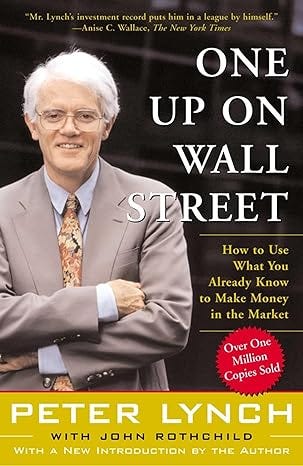Peter Lynch: “Buy what you know” (but don’t stop there)
On tenbaggers and Labubu-dolls
Welcome back for another Guru Gems edition!
I study long-term investing masters and write about what I learn.
Today I cover a timeless classic in investing: One Up on Wall Street (How To Use What You Already Know To Make Money In The Market) by Peter Lynch.
Lynch is one of the most successful mutual fund managers ever. He managed the Fidelity Magellan Fund from 1977 to 1990, compounding capital at ~29% annually — transforming a $20 M fund into $14 B
Follow me on X @guru_gems for more investing insights and make sure to subscribe for weekly deep-dives
In my latest deep-dive I covered Chuck Akre and a possible Gem from his portfolio:
One Up On Wall Street
Peter Lynch wrote the first version of this classic book in 1989. The lessons in it are still as relevant as ever.
Lynch explains the advantages that average investors have over professionals and how they can use these to achieve financial success.
The book is often reduced to “Invest in what you know” but that’s a bit simplistic and there is obviously much more to it.
Step 1: The amateur’s edge
What is the best place to find ‘tenbaggers/multibaggers’ (stocks that appreciate tenfold or more) ?
Lynch says to observe your daily life: Look for investment opportunities by simply observing business developments, from the mall to the workplace. This allows you to discover potentially successful companies before professional analysts do.
Many of Lynch's winners were mundane, easy-to-understand companies he encountered daily, like Dunkin' Donuts or Wal-Mart....
Step 2: Developing the story
Simply liking or using a businesses’ product is not enough reason to buy the stock.
What you’ve got so far is simply a lead to a story that has to be developed.
Never invest before doing homework on a company's earnings prospects, financial condition, competitive position, and expansion plans.
Investing without research is like playing poker and never looking at the cards.
Lynch came up with 6 categories, that should help an investor to better understand what could be expected from a stock.
Slow Growers (Sluggards) - Usually large and aging companies that are expected to grow slowly faster than the gross national product. You mostly buy these companies for the dividends.
Medium Growers (Stalwarts) - Big companies that aren’t likely to go out of business. They grow a bit faster than the slow growers and depending on when you buy them and at what price, you can make a sizable profit in them.
Fast Growers - Superstocks that deserve the most attention; small, aggressive new enterprises that grow 20-25 percent a year. Lynch looks for the ones that have good balance sheets and are making substantial profits.
Cyclicals - Companies whose sales and profits rise and fall in regular or completely predictable fashion. Timing is everything to profit from cyclicals.
Turnarounds - These are no-growers that have been battered and depressed. The benefit of investing in successful turnarounds is that their ups and downs are least related to the general market.
Asset Plays - Companies that are sitting on something valuable that you know about, but that the Wall Street crowd has overlooked.
Putting stocks in categories is the first step in developing the story. Now at least you know what kind of story it’s supposed to be. The next step is filling in the details that will help you guess how the story is going to turn out.
Step 3: Filling in the details
The next step is about better understanding the basic business. For this, Lynch recommends some key numbers and factors to check.
Price/Earnings (P/E) ratio
Lynch advises investors to follow the earnings if they can follow only one piece of data. He points out that stock prices tend to follow earnings over the long term.
Therefore the P/E ratio (stock price divided by annual earnings per share) is a crucial measure of valuation.
A fairly priced company's P/E ratio should roughly equal its growth rate. If the P/E is half the growth rate, it's attractive. If it's double, it's unattractive.
In other words, you can pay a higher P/E multiple for stocks that are growing earnings faster. This ‘PEG ratio’ - P/E ratio divided by Earnings Growth Rate - was popularized by Peter Lynch.
Cash position & debt
Companies with more cash than debt are financially strong. High debt, especially ‘bank debt’, is a major risk.
Insider buying & share buybacks
These are strong positive signs that management believes in the company's future.
Institutional ownership
Look for stocks with little or no institutional ownership, as this suggests they haven't been ‘discovered’ yet by Wall Street.
Step 4: The two-minute drill
Before buying a stock, I like to be able to give a two-minute monologue that covers the reasons I’m interested in it, what has to happen for the company to succeed, and the pitfalls that stand in its path. […]. Once you’re able to tell the story of a stock to your family, your friends, […] and so that even a child could understand it, then you have a proper grasp of the situation.
For fast growers, for example, the monologue should address topics like where and how it can continue to grow fast. If the business is good in one location, is it also successful in other locations?
Step 5: Managing the portfolio
Lynch emphasizes the importance of being patient: Most of Lynch's significant gains came in the third or fourth year of holding a stock, or even longer.
Sell when the story changes
Don't sell simply because a stock has doubled. Sell when the fundamentals of the company deteriorate, the original reasons for buying are no longer valid, or the company enters a problematic phase (like market saturation for fast growers).
Avoid watering the weeds
Don't automatically sell winners and hold onto losers. Instead, rotate out of situations where fundamentals worsen and into those where they improve, even if the price is down.
Monitor progress
Finally, remember that companies don’t stay in the same category forever.
Periodically recheck the company story by reviewing reports, checking earnings, and observing the business in real life (e.g. visiting stores). Determine if the company is moving between growth phases (start-up, rapid expansion, mature, …).
Bonus - Lynch’s ‘Perfect Stock’
In his book, Peter Lynch shares what his ‘Perfect stock’ looks like.
Lynch prefers investing in simple, dull, or even ‘ridiculous’ businesses (like bottle caps or auto parts washing) that “any idiot could run” because they are easier to understand and often overlooked by Wall Street.
Here are his most favorable attributes when looking for stocks to invest:
It sounds dull or it does something dull
It’s a spinoff (This one probably inspired Joel Greenblatt)
The institutions don’t own it, and the analysts don’t follow it - Just like the previous one, this is something Joel Greenblatt emphasized in his books)
It does something disagreeable or there’s something depressing about it
It’s a no-growth industry
It’s got a niche or people have to keep buying it
The insiders are buyers
The company is buying back shares
If I could avoid a single stock, it would be the hottest stock in the hottest industry, the one that gets the most favorable publicity, the one that every investor hears about in the car pool or on the commuter train - and succumbing to the social pressure, often buys.
Just like the perfect stocks, there are also stocks that Lynch would avoid at any cost:
Hot stocks/industries: These often attract too much competition, lack underlying value, and can fall as quickly as they rise.
‘Next something’ companies: Be wary of companies touted as “the next [famous successful company]”, especially if they are in unrelated fields (‘diworseification’).
Stocks with exciting names: Flashy names can attract investors to mediocre companies and provide a false sense of security.
Blindly buying low-priced stocks: A stock at $3 can still lose 100% of your investment if it goes to zero, just like a $50 stock.
Now let’s apply what we’ve learned from Peter Lynch to something observed in our daily life…
Labubu dolls
If you’re on Tiktok or if you’re a parent, chances are you’ve seen Labubu dolls — quirky figurines made by Chinese toy company Pop Mart International Group Ltd.
They’re everywhere: in shopping malls, TikTok unboxings, and even vending machines. With a near cult-like following and growing global reach, Pop Mart seems like a Lynch-style ‘invest in what you see’ story.
But is it really?
Let’s walk through the five steps we laid out:
Amateur’s edge: Many investors could have discovered Pop Mart because their kids started talking about Labubu, or they saw lines outside a Pop Mart store. Unfortunately, by now Wall Street already saw it happen as well and Pop Mart’s stock increased more than 500% in the last year.
Developing the story: Pop Mart could be categorized as a fast grower. But is the growth sustainable or is it driven by fad?
Lynch warns that, when investing in a hot product, the story may already be baked into the stock price.
Filling in the details: P/E Ratio: ~93x (as of 22 June 2025) ⛔ This is extremely high. PEG Ratio: Let’s say Pop Mart’s earnings are growing at ~25% — that would imply a PEG of 3.7, which Lynch would consider very unattractive.
The two-minute drill: I think the monologue story would rely heavily on continued hype and momentum, and not really long-term fundamentals.
Managing the portfolio: Would you hold Pop Mart for 5+ years if the stock dropped 40%? Would you still love it if Labubu fell out of favor?
Conclusion:
While Pop Mart may pass Lynch’s first hurdle as a product you know, see, and understand, it fails every other step beyond that.
Hot stocks can go up fast, usually out of sight of any of the known landmarks of value, but since there’s nothing but hope and thin air to support them, they fall just as quickly. If you aren’t clever at selling hot stocks (and the fact that you’ve bought them is a clue that you won’t be), you’ll soon see your profits turn into losses, because when the price falls, it’s not going to fall slowly, nor is it likely to stop at the level where you jumped on.
“The big money is not in the buying or selling, but in the waiting”
— Charlie Munger
I will be back next week with a new Guru and a potential new Gem to look into!



